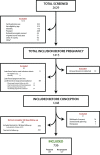Marked reduction in fertility among African women with urogenital infections: A prospective cohort study
- PMID: 30629655
- PMCID: PMC6328149
- DOI: 10.1371/journal.pone.0210421
Marked reduction in fertility among African women with urogenital infections: A prospective cohort study
Abstract
Background: There is paucity of data on risk factors for reduced fertility in low-income countries.
Objective: To investigate factors associated with fertility among women in rural north eastern Tanzania.
Subjects and methods: A cohort of 1248 non-pregnant women was followed with urine pregnancy testing every third month or more regularly if they reported a missed menstrual period. Pregnancy was confirmed with trans-abdominal ultrasound. Information regarding general health, socioeconomic status and obstetric-gynaecological history was collected. Factors associated with conceiving within 180 days were identified using multivariate logistic regression analyses.
Results: Among the 1248 women, 736 were followed for 180 days and 209 of these had an ultrasound confirmed pregnancy. During the follow-up period, 169/736 women were diagnosed with urogenital infections, including suspected sexually transmitted or reproductive tract infections, urinary tract infection, and vaginal candidiasis. Urogenital infections were significantly associated with reduced odds of conceiving within 180 days (adjusted OR (AOR) 0.21, 95% CI 0.11-0.36). Being above 30 years of age was also negatively associated with odds of conceiving (AOR 0.45, 95% CI 0.26-0.77). In contrast, women who recently stopped using hormonal contraceptives (AOR 2.86, 95% CI 1.45-5.70) and women with low socioeconomic status (AOR 1.56, 95% CI 1.04-2.33) were significantly more likely to become pregnant within 180 days.
Conclusion: Urogenital infection seems to be a major health factor associated with reduced chances of conceiving. Considering the availability of effective treatment options for these diseases, public health authorities should increase awareness of diagnostic tools in settings with limited resources in order to improve fertility.
Conflict of interest statement
The authors have declared that no competing interests exist.
References
-
- WHO. Infertility definitions and terminology.Available from: http://www.who.int/reproductivehealth/topics/infertility/definitions/en/.
-
- WHO. Reproductiv health.Available from: http://www.who.int/topics/reproductive_health/en/.
-
- Basso O, Olsen J, Bisanti L, Bolumar F, Kuppers-Chinnow M. Repeating episodes of low fecundability. A multicentre European study. The European Study Group on Infertility and Subfecundity. Human reproduction (Oxford, England). 1997;12(7):1448–53. - PubMed
-
- Borghtb MV WC. Fertility and infertility: Definition and epidemiology. Clinical Biochemistry. 2018. - PubMed
Publication types
MeSH terms
LinkOut - more resources
Full Text Sources


